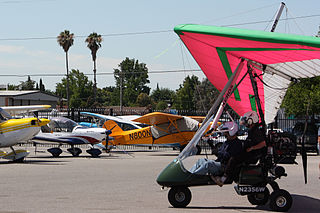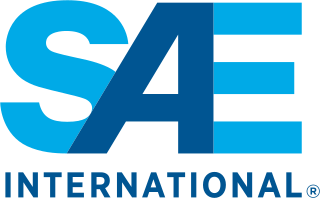Related Research Articles
The Federal Aviation Regulations (FARs) are rules prescribed by the Federal Aviation Administration (FAA) governing all aviation activities in the United States. The FARs comprise Title 14 of the Code of Federal Regulations. A wide variety of activities are regulated, such as aircraft design and maintenance, typical airline flights, pilot training activities, hot-air ballooning, lighter-than-air aircraft, human-made structure heights, obstruction lighting and marking, model rocket launches, commercial space operations, model aircraft operations, Unmanned Aircraft Systems (UAS) and kite flying. The rules are designed to promote safe aviation, protecting pilots, flight attendants, passengers and the general public from unnecessary risk.

Pilot licensing in Canada is administered by Transport Canada under the Aeronautics Act and the Canadian Aviation Regulations (CARs).

A type certificate signifies the airworthiness of a particular category of aircraft, according to its manufacturing design. Certification confirms that the aircraft of a new type intended for serial production is in compliance with applicable airworthiness requirements established by the national air law.
An airworthiness directive is a notification to owners and operators of certified aircraft that a known safety deficiency with a particular model of aircraft, engine, avionics or other system exists and must be corrected.

A light-sport aircraft (LSA), or light sport aircraft, is a category of small, lightweight aircraft that are simple to fly. LSAs tend to be heavier and more sophisticated than ultralight aircraft, but LSA restrictions on weight and performance separates the category from established GA aircraft. There is no standard worldwide description of an LSA.

ARP4754, Aerospace Recommended Practice (ARP) ARP4754B, is a guideline from SAE International, dealing with the development processes which support certification of Aircraft systems, addressing "the complete aircraft development cycle, from systems requirements through systems verification." Revision A was released in December 2010. It was recognized by the FAA through Advisory Circular AC 20-174 published November 2011. EUROCAE jointly issues the document as ED–79.
The Canadian Aviation Regulation Advisory Council (CARAC) is the main public consultative body involved in creating and amending the Canadian Aviation Regulations and is a joint effort of Transport Canada and the Canadian aviation industry.
An aircraft part is an article or component approved for installation on a type-certificated aircraft. Approval for these parts is derived from the jurisdictions of the countries that an aircraft is based. In the United States, the Federal Aviation Administration oversees the approval for these parts under Federal Aviation Regulation Part 21.
Parts Manufacturer Approval (PMA) is an approval granted by the United States Federal Aviation Administration (FAA) to a manufacturer of aircraft parts.

In aviation, airworthiness is the measure of an aircraft's suitability for safe flight. Initial airworthiness is demonstrated by a certificate of airworthiness issued by the civil aviation authority in the state in which the aircraft is registered, and continuing airworthiness is achieved by performing the required maintenance actions.

Cross-country flying is a type of distance flying which is performed in a powered aircraft on legs over a given distance and in operations between two points using navigational techniques; and an unpowered aircraft by using upcurrents to gain altitude for extended flying time. Cross country is distinct from purely aerial work in a small defined area requiring little navigation.

In aviation, V-speeds are standard terms used to define airspeeds important or useful to the operation of all aircraft. These speeds are derived from data obtained by aircraft designers and manufacturers during flight testing for aircraft type-certification. Using them is considered a best practice to maximize aviation safety, aircraft performance, or both.

Civil aviation is one of two major categories of flying, representing all non-military and non-state aviation, both private and commercial. Most countries in the world are members of the International Civil Aviation Organization and work together to establish common Standards and Recommended Practices for civil aviation through that agency.

General aviation (GA) has been defined as a civil aircraft operation other than a commercial air transport flight operating to a schedule. Although the International Civil Aviation Organization (ICAO) excludes any form of remunerated aviation from its definition, some commercial operations are often included within the scope of General Aviation (GA). General aviation refers to all flights other than military and scheduled airline flights, both private and commercial.
The Directorate General of Civil Aviation (DGCA) is a statutory body of the Government of India to regulate civil aviation in India. It became a statutory body under the Aircraft (Amendment) Act, 2020. The DGCA investigates aviation accidents and incidents, maintains all regulations related to aviation and is responsible for issuance of licenses pertaining to aviation like PPL's, SPL's and CPL's in India. It is headquartered along Sri Aurobindo Marg, opposite Safdarjung Airport, in New Delhi. The Government of India is planning to replace the organisation with a Civil Aviation Authority (CAA), modelled on the lines of the American Federal Aviation Administration (FAA).

The Civil Aviation Authority of Nepal is an independent civil aviation regulator. It was established as a Nepali government body in 1998 and is headquartered in Kathmandu.
In Canada an Aircraft maintenance engineer (AME) is a person who is responsible for signing the maintenance release of certified aircraft and is licensed to do so by the national airworthiness authority, Transport Canada (TC). Their job is to ensure that aircraft are maintained in a safe condition.

Advisory circular (AC) refers to a type of publication offered by the Federal Aviation Administration (FAA) to "provide a single, uniform, agency-wide system … to deliver advisory (non-regulatory) material to the aviation community." Advisory circulars are now harmonized with soft law Acceptable Means of Compliance (AMC) publications of EASA, which are nearly identical in content. The FAA's Advisory Circular System is defined in FAA Order 1320.46D.

AC 25.1309–1 is an FAA Advisory Circular (AC) that identifies acceptable means for showing compliance with the airworthiness requirements of § 25.1309 of the Federal Aviation Regulations. Revision A was released in 1988. In 2002, work was done on Revision B, but it was not formally released; the result is the Rulemaking Advisory Committee-recommended revision B-Arsenal Draft (2002). The Arsenal Draft is "considered to exist as a relatively mature draft". The FAA and EASA have subsequently accepted proposals by type certificate applicants to use the Arsenal Draft on development programs.
References
- 1 2 Transport Canada (June 2008). "Canadian Aviation Regulations (CARs)". Archived from the original on April 10, 2019. Retrieved September 28, 2015.
- ↑ Transport Canada (June 2007). "Aeronautics Act R.S. 1985, c. A-2" . Retrieved March 31, 2009.
- ↑ Transport Canada (December 2007). "About The Canadian Aviation Regulations (CARs)" . Retrieved July 26, 2008.
- 1 2 Transport Canada (December 2007). "General Information on the CARs" . Retrieved July 26, 2008.
- ↑ Transport Canada (January 2008). "Part V – Airworthiness" . Retrieved July 26, 2008.
- ↑ Transport Canada (January 2008). "Canadian Aviation Regulation Advisory Council (CARAC) Notice" . Retrieved July 26, 2008.
- ↑ "Advisory Circulars (ACs)" . Retrieved April 17, 2023.
- ↑ "Commercial and Business Aviation Advisory Circulars (CBAACs)" . Retrieved April 17, 2023.
- ↑ "General Aviation Advisory Circulars (GAACs)" . Retrieved April 17, 2023.
- ↑ "Aerodrome Safety Circulars (ASCs)" . Retrieved April 17, 2023.
- ↑ "General Aviation Policy Letters (GAPLs)" . Retrieved April 17, 2023.
- ↑ "Maintenance and Manufacturing Policy Letters (MPLs)" . Retrieved April 17, 2023.